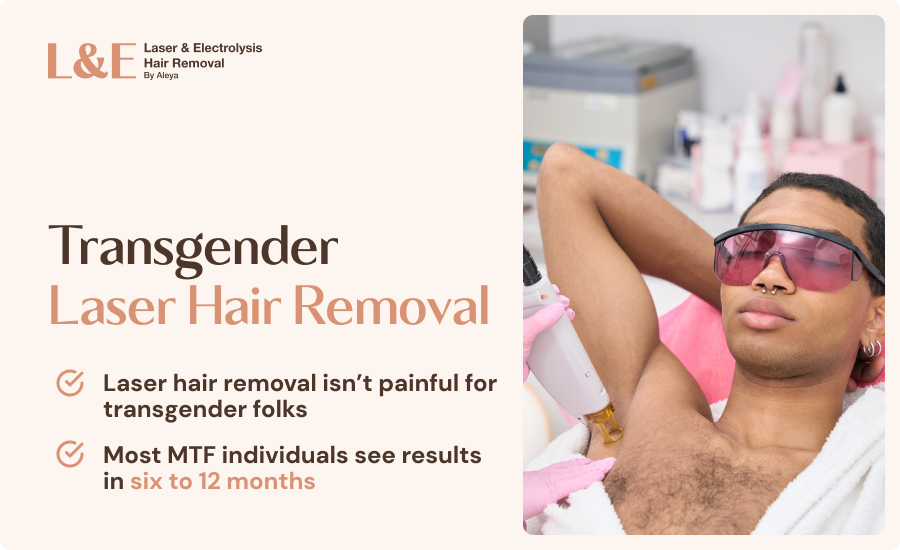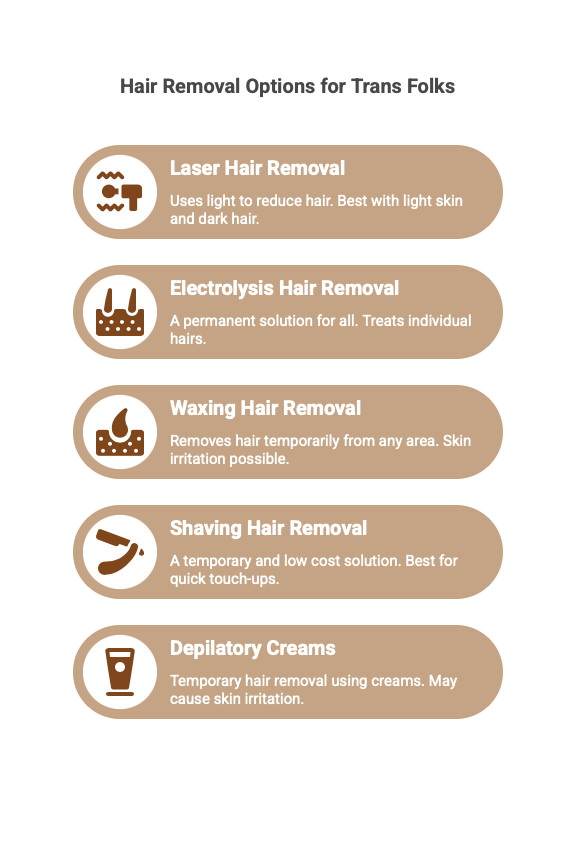Transgender Laser Hair Removal: What To Expect & MTF Timeline

Transgender Laser Hair Removal: Key Takeaways
- Laser hair removal is generally not painful, making it a great option for transgender individuals reducing unwanted hair
- Most MTF individuals see full results in six to 12 months with consistent laser treatments
- Laser hair removal is a go-to choice for many MTF folks because it’s safe, effective, and cost-efficient
If you’re a male-to-female (MTF) transitioning individual, chances are you’ve already started exploring different ways to manage unwanted hair, laser hair removal already being on your radar.
But with so much conflicting advice and recommendations out there, it’s difficult to know what really works and what’s right for your body.
That’s why we put together the ultimate guide to laser hair removal for MTF transitions: to give you real answers and help you make confident, informed choices.
Does Laser Hair Removal Hurt for Transgender People?
No, laser hair removal isn’t painful, which makes it a great option for transgender individuals looking to reduce unwanted hair.
Most people describe the sensation as a mild pinch or a rubber band snapping against the skin.
Discomfort can vary based on the area being treated, how thick your hair is, and your pain tolerance, but for most folks, it’s manageable.

Male-to-Female (MTF) Laser Hair Removal Timeline
Wondering what the journey looks like? Let’s walk through a typical laser hair removal timeline for MTF transitions.
| Month | What To Expect |
| 0 | You’ll begin with an initial consultation and test patch. |
| 1 to 3 | You might begin to notice a visible reduction in hair, although the results can vary depending on the area and the individual. |
| 4 to 6 | Hair typically becomes finer and sparser during this stage. |
| 6 to 12 | Many individuals experience noticeable thinning and slower regrowth. |
| 12+ | You can schedule maintenance sessions as needed, and some individuals choose electrolysis for smaller areas to achieve permanent results. |
Just remember, every transition is personal, and everyone’s goals are different.
The right time to start laser hair removal depends on what feels best for you.
Why Do Trans Folks Choose Laser Hair Removal?
Laser hair removal is a popular choice during MTF transitions because it’s safe, effective, and often more cost-efficient, especially for treating larger areas like the face, legs, underarms, chest, and back.
It’s especially useful for larger areas, like the face, legs, underarms, chest, and back, and most people see a noticeable reduction in hair after just a few sessions.
But here’s the thing: it’s not a permanent fix.
Some trans folks might feel disappointed when they learn that laser doesn’t remove every hair for good.
Over time, a few hair strands may grow back.
The upside? That regrowth is usually finer, lighter, and less noticeable.
If you’re aiming for complete, permanent removal, especially in more visible areas, electrolysis is the next step.

How Does Laser Hair Removal Work?
Laser hair removal works by using focused pulses of light to target the pigment in hair follicles.
The follicles absorb this light, which damages them and slows down future hair growth.
At Laser by Aleya, we use the LightSheer Diode Laser, one of the safest lasers available.
Its longer wavelength allows for deeper penetration, making it a better and safer choice for darker or tanned skin compared to older lasers like the Ruby.
How Long Does Laser Hair Removal Take?
Laser hair removal typically takes seven to 12 sessions, spaced four to six weeks apart, for long-lasting results.
You’ll start seeing thinner, sparser regrowth after a few treatments, with hairs shedding between sessions.
While laser hair removal doesn’t offer permanent results, you can maintain smooth results with consistent touch-up sessions and a skincare routine that supports healing and reduces irritation.

Are You Eligible for Laser Hair Removal?
Before booking a session, it’s important to know if you’re a suitable candidate for laser hair removal.
- Laser hair removal works best on darker hair, such as black or dark brown, as the laser targets melanin in the hair follicle.
- Lighter hair shades, like light brown, blonde, red, white, or gray, typically don’t respond well to the treatment. If that’s your case, electrolysis might be a better option.
- Lighter skin tones see the best results due to the higher contrast between hair and skin, making it easier for the laser to target follicles.
- Darker skin tones can still benefit from laser hair removal with the right technology
- The LightSheer Diode Laser is designed to treat a wide range of skin tones, including Middle Eastern, Indian, Mediterranean, and African complexions.
- These skin types often come with darker, coarser hair, which means noticeable results with minimal risk of skin damage.
Combining HRT With Laser: What You Should Know
Gender-affirming hormone replacement therapy is the process of taking hormones like estrogen or testosterone, or hormone blockers, to support physical changes that align with a person’s gender identity.
In a nutshell, here’s what you should know about HRT:
- HRT can reduce hair growth over time, especially body and facial hair, by lowering testosterone and increasing estrogen levels.
- HRT doesn’t remove hair, so areas with existing dense hair (like the face) still require laser or electrolysis.
- Some individuals begin laser before starting HRT, as it’s more accessible, requires fewer medical approvals, and helps address dysphoria early in transition.
- Others do both at the same time, which is safe and can sometimes speed up hair reduction, especially in areas like the face and chest.
- Many trans folks also start with high-priority areas like the face, focusing on visibility and budget before expanding to other areas.
- Some people prefer to wait until their hormone levels stabilize and hair growth plateaus to better assess the extent and persistence of unwanted hair.
Keep in mind that there’s no one-size-fits-all answer. The best plan is the one that supports your goals, comfort, and transition timeline.
Hair Removal Options for Transgender Individuals
This image breaks down common hair removal methods to help you choose what best supports your transition and goals.

Start Your Hair Removal Journey With Confidence at Laser by Aleya
Whether you’re just beginning your transition or looking to refine your results, laser hair removal can be a step toward softer and smoother skin.
At Laser by Aleya, we proudly support transgender clients and understand how personal this journey can be.
We understand that gender-affirming care is deeply personal, and hair removal can be an important part of feeling more at home in your body.
That’s why we listen closely, answer your questions, and tailor every treatment to your goals.
With experience, care, and respect at every step, Aleya is a trusted laser specialist and certified electrologist offering both laser hair removal and electrolysis, right here in Great Neck, NY.


